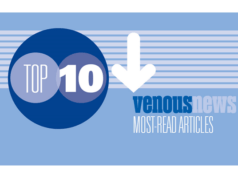
Three-year results of the VIVO clinical study support the continued safety and effectiveness of the Zilver Vena venous stent (Cook Medical) in the treatment of symptomatic iliofemoral venous outflow obstruction, a press release from the VIVA Foundation summarises. Paul Gagne (The Vascular Experts, Darien, USA) presented the new data at Vascular Interventional Advances (VIVA) 2021 (5–7 October, Las Vegas, USA).
Patients with symptomatic obstruction of one iliofemoral venous segment were enrolled (i.e. Clinical, etiology, anatomy, pathophysiology [CEAP] clinical classification ≥3 or Venous Clinical Severity Score [VCSS] pain score ≥2). Follow-up through three years included measures of patency, reintervention, clinical outcomes (measured by VCSS, Venous Disability Score [VDS], CEAP “C”, and Chronic Venous Insufficiency Questionnaire [CIVIQ]), and device integrity measures of fracture and migration.
The VIVO study enrolled 243 patients (70% female; mean age, 53±15 years; 67.5% with current or past deep vein thrombosis). The 30-day primary safety endpoint and 12-month primary effectiveness endpoint were met, exceeding the corresponding performance goals (p<0.0001), and improvement in clinical outcome measures was demonstrated at 12 months (p<0.0001).
Follow-up through three years is complete, Gagne told VIVA attendees, reporting that results observed at 12 months were maintained. Specifically, three-year outcomes include high rates of patency by ultrasound (90.3±2.2%), freedom from clinically-driven reinterventions (92.6± 2%), and freedom from reinterventions (82.9±2.6%). Clinical improvement, as measured by VCSS, VDS, CEAP “C”, and CIVIQ, was sustained through three years (p<0.0001).
There were no core lab-reported stent fractures, and only one core lab-reported migration (adjudicated as technique-related due to device undersizing) through three years.









